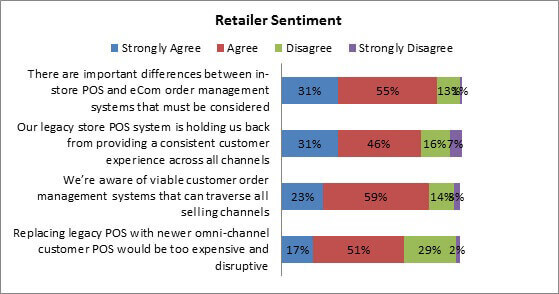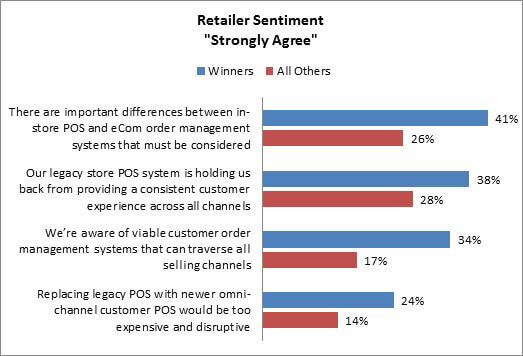Retailers Weigh In On The State Of The Digital/Physical Union
With the proliferation of digital channels in retail, we recently took on the task of understanding how retailers view the state of the union. How do retailers, themselves, currently view the challenges, opportunities, roadblocks and technology enablers associated with how they support commerce across all of their consumer touchpoints – both physical and digital?
We were encouraged to find that when we asked 88 different retailer respondents to rate their approval of some cross-channel conceptual statements they uniformly told us that they know their disparate systems are currently holding them back. The bad news? Not enough have a strong awareness of viable alternatives yet, and many have a deep-rooted belief that they’ll be stuck in this situation for quite some time to come (Figure 1, below).
Figure 1: The State Of The Union

Source: RSR Research, June 2015
It’s quite telling that retailers recognize the largest tech investment in their possession – the POS system – is a large part of what’s holding them back from providing a seamless experience across all of their customer touch points. It’s incredibly difficult to satiate a customer’s needs when, should that customer decide to visit a store (where more than 90% of sales still conclude), virtually all of their online pre-purchase behavior is entirely invisible to in-store staff. We also maintain that such information is needed in-store well before the customer reaches the POS.
Yet there’s a telling indicator of how this story – albeit early days in the channel-less shopping experience story – is starting to unfold. Take a look at how this same data plays out when viewed by retailer sales performance (Figure 2).
Figure 2: Different Lens, Sharper Picture

Source: RSR Research, June 2015
Winning Retailers are much more likely to understand the importance of synchronous order management systems (41 vs. 26%, above) and yet be hampered by the visibility of orders across touchpoints (34% vs. 17%), while at the same time being more held back by legacy in-store POS systems – systems they perceive as being too expensive to replace. What does this tell us?
First, that Winners are clearly much further along in the process of trying to provide a truly channel-less experience. They understand the challenges better because they’ve already been at it longer. They’ve got scars. However, there is still much work to be done on the part of the community, as a whole, to inform retailers – even the best performers – that viable solutions already exist to help bring them into the 21st century.
In many ways, it’s worth a reminder that we are already 15 years into that new century, yet stores don’t often reflect that reality. And while we will delve into which technological features are becoming most valued within the full report, as well as which are most feasible to retailers from both a cost and disruptive standpoint, the burden of proof remains on solutions providers to educate retailers as to what their next-gen products can doright now; no easy feat in the face of deeply-held cultural beliefs that modernization will be both expensive andpainful. Whether held in error or not, this is what retailers believe, and must be met head-on before wide-scale progress can take place.
If you are interested in reading the full report, it is available here.
